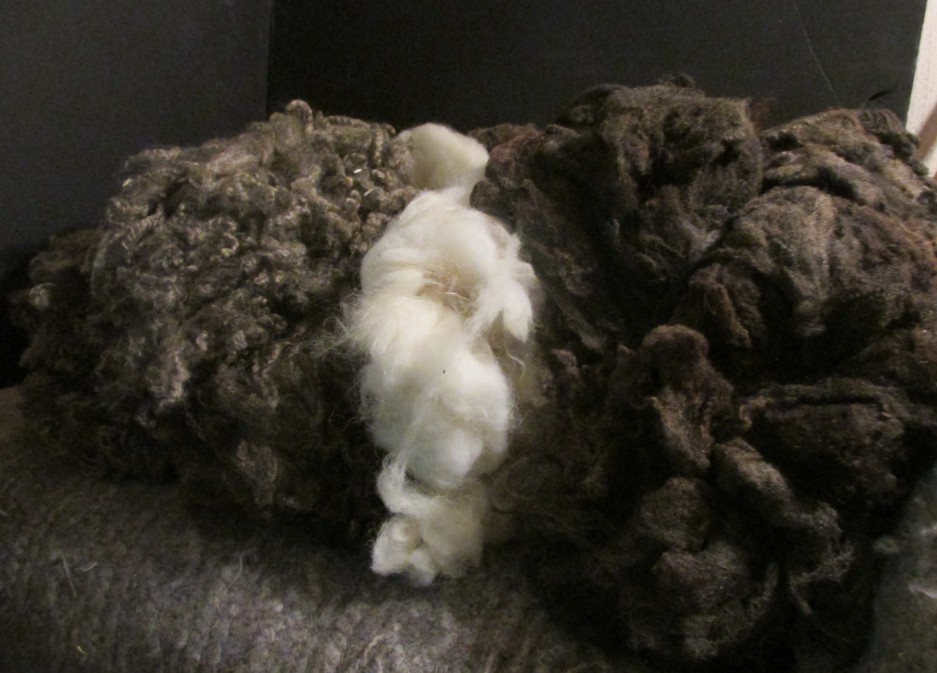Hello
FIBERuary Day 11 Angora Rabbits with Jenny Atkins- Spinner, Angora Rabbit Breeder
Part One
Be sure and come to Sheep and Shawl On Sunday, February 14th from 1 to 3 pm to hear Jenny’s talk about Angora Rabbits..

ANGORA RABBITS – THE PERFECT FIBER ANIMAL!
I have been raising angora rabbits for about 20 years. I consider myself in no way an expert but I have learned some things over the years and can try to pass them on.
I consider angoras the “perfect fiber animal” because they are relatively inexpensive to acquire and keep, take little space, and produce the most luxurious of fibers. And besides that they sure are cute! I would add that they are easy to care for, but that is not always the case; they can be tricky at times. Still, for someone who really likes to get down to the basics and beginnings of things (and I’ll be honest, likes to be in control) but lives in town where the term “livestock” makes people nervous, rabbits are perfect. No room for sheep? No pastures or barns in your future? No problem.
There are many ways to house and care for angora rabbits. I will describe what I do. For more ideas and further information, look online, there is a wealth of information there.
HOUSING
I keep my rabbits outdoors all year round in wire cages set into wooden shelters. They do fine in the cold (after all, they are wearing full-body angora coats!) as long as they are protected from rain, snow and wind. Summer is a potentially bigger problem, as they can overheat. In the heat they MUST have water at all times and adequate shade and ventilation. If it gets really hot I will sometimes mist the cages or add a large 2 liter soda bottle filled with frozen water. Although tempting, it is not a good idea to bring your rabbit inside to an air conditioned or heated house just to warm up, or cool down for a bit. This sudden temperature change will stress the rabbit more than leaving it outside. The cages are 30 inches wide by 36 inches deep by 24 inches high. That gives plenty of room for them to move around freely and to stand upright. I use 16 gage 1 inch by 2 inch wire for the sides and tops, and 14 gage ½ inch by 1 inch wire for the bottoms. The bottom wire needs to be large enough for bunny poops to fall through, but small enough to adequately support the rabbit. And the higher gage means it lasts longer. Rabbit urine is quite caustic and will eventually wear away the wire. I make these cages myself and it is not hard to do, but truth be told, I also have a wide variety of “hutches” of one sort or another that I have scrounged from here and there. Just be sure the hutch is big enough, has proper flooring and enough shelter.
FEEDING
What about food? I feed my rabbits 1/3 cup am and pm with a mix of pellets, oats and sunflower seeds. Evenings they also get a big handful of good quality (but grass, not alfalfa) hay. If you look online, or ask rabbit breeders, you will find any number of feeding regimes. I can’t speak for all of them, but this one has worked well for me. I use 9 parts Blue Seal Hutch Plus 18, 1 part crimped oats and ½ part black oil sunflower seeds. These are all readily available from my local grain store, though I must have them special order the Hutch Plus. I prefer it because it has 18% protein. Angora rabbits, unlike short-haired rabbits, are working hard to grow all that extra hair and need that boost of protein. Once a week (or so) I feed just oats and hay for the evening feeding as a help to prevent wool-block (see below). And fresh, not frozen water for each feeding. I use tHe drip bottles that attach to the outside of the cage. I have heard that rabbits drink more from a dish than a drip bottle, but that is what I have.
Part two coming soon
